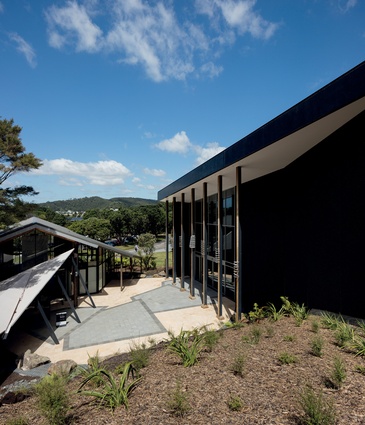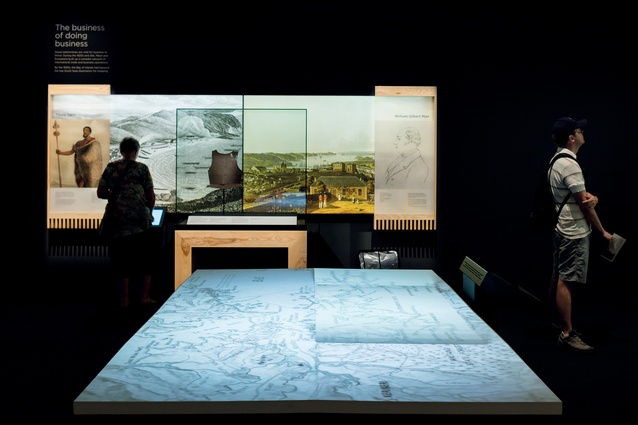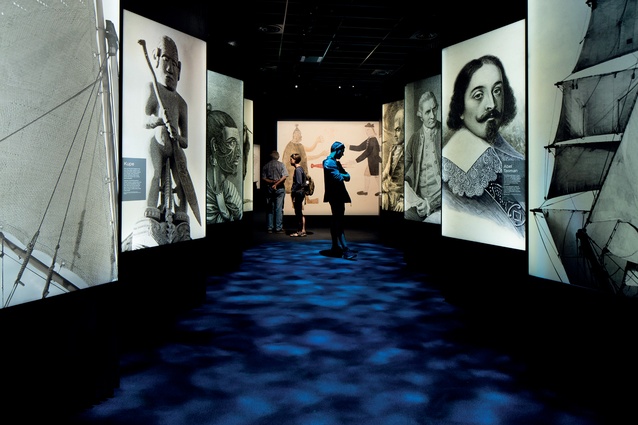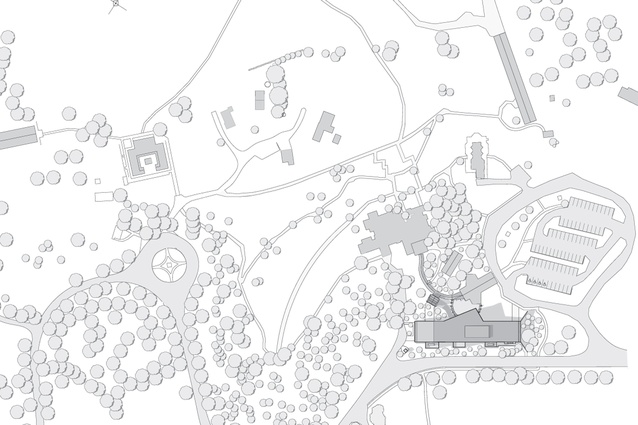Te Kōngahu / Museum of Waitangi
Harris Butt Architecture’s new museum at Waitangi is an intentionally subtle addition to a cluster of important buildings that speak about New Zealand’s history.
First, let’s allay any fears: the old John Scott building is still there in the Waitangi Treaty Grounds. When I first heard about the new Waitangi Museum, I was worried that his 1983 Visitor Centre may be going the way of his similar 1974 building at Āniwaniwa, Lake Waikaremoana − demolition by officially sanctioned neglect on the basis that the building doesn’t meet modern requirements. It has had a few changes over the years, but the building has now sprouted a little sign that mentions Scott, his background and the design concept behind his Visitor Centre.
The architects of the new museum, Harris Butt Architecture, have been involved with the Waitangi National Trust for several years now and they also have a great deal of respect for the Scott building and their 2009 Waitangi Gateway Building indicates that. So now we can turn our attention to the latest addition to the Treaty Grounds, the Museum of Waitangi.
If you have never been there, it is absolutely worth it for the architecture, among other things. There is the 1834 prefab-Georgian of Busby’s house − from when he was resident and we were an outpost of New South Wales; the Whare Rūnanga, a result of the Āpirana Ngata’s Rotorua School of Māori Arts and Crafts, commissioned for the 1940 centenary; and sundry other smaller buildings.
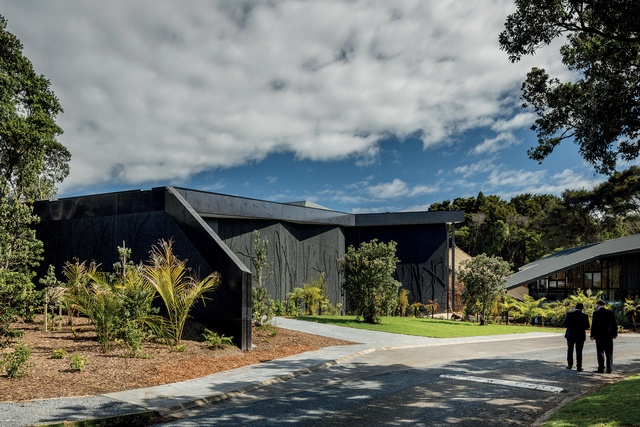
The spot where the Copthorne Hotel sits is worth a look too: the original 1960s’ building (which you can still detect elements of, designed by William Pearson) was one of the government-owned Tourist Hotel Corporation’s buildings at key national sites, including Mt Cook, Rotorua and Waitomo. But much earlier than that, this little patch of flat land below the Treaty Grounds was the site of the country’s very first town plan: ‘Victoria’ − designed by Felton Mathew for Busby although never built. Felton Mathew also created Auckland’s town plan, which, this being New Zealand, we never followed, of course.
As you will gather, I was worried that the new museum would supplant Scott’s work but, actually, it’s an addition to the precinct. At the carpark near the entrance to the Grounds, the museum at first sight is a big step up in scale and mass compared to the smaller and more airy, gabled waharoa of the Gateway Building (not to be confused with Scott’s Visitor Centre, which is further into the bush).
It’s a rather hefty building by comparison, with a lid of roof expressed as eave over the zig-zag panels of the side wall, but the rising roof also works to point the way to an entrance only partially glimpsed from the outside. The relief work on the concrete panels is by artist/craftsman/designer Carin Wilson and relates to flora and fauna of our whenua, and people past, present and future. As planting grows up the panels, these works of man and nature will intermingle much more distinctly.

The other sides of the Museum building are also intended to be concealed by planting. I see this as entirely appropriate for buildings that aren’t there primarily to be sculptural objects viewed from all sides, but structures which channel experience. Even Scott’s much-admired Visitor Centre is not a building we stroll around; like that at Āniwaniwa and, in many ways, like the meeting house, it is a building we have an initial frontal relationship with and then it shapes and guides our experience as we move from atea, past paepae, through porch, and then a sequence of interior spaces before emerging in the bush to take the pathway uphill to the Treaty Grounds.
Through the Gateway Building, one receives the full and proper first impression of the Museum building in a similar way to entering a marae via a waharoa. The Museum forecourt has a circular atea, or open space, and an exquisite set of pou, or poles, also by Carin Wilson, which stand on small stones and reach up to support the Museum’s canopy. This is not a marae, of course, and this is not a wharenui, and there is no gabled roof; but the pou, to me, are resonant of a cross-cultural conversation forming an almost classical façade with a fine arch traced out and reminiscent of the verandah posts of Busby’s British residency that confronted Māori in the 1830s when it was the first government building in the land.
Beyond the entrance lobby and its stairs up to the second-floor areas, the interior is a black-box-style museum, a space that Scott’s building could never provide. As you disappear into its darkness, you are, as in any good exhibition, transported into a different realm. In many ways it is complementary to Scott’s visitor centres here and at Āniwaniwa, where he aimed to counterpoint your pathway through an exhibition with a sequence of spatial experiences and glimpses through carefully-placed windows of the outside world and the bush.

In this building, the requirements of a museum-quality environment, security and the desire for an experience choreographed through artificial light and darkness mean that the taonga of another time and place take precedence over architectural space. The exhibition space holds many taonga such as the recently repatriated medal presented to Bay of Island’s chief Te Pahi and the wonderful carved self-portrait by Hongi Hika, two objects that until now could never be safe in the region they came from and to which they belong.
The exhibition pathway and Museum building deposits the visitor via a buried tunnel back on the path to the Visitor Centre and, from there, you head off up to the Treaty Grounds proper. The Museum also continues to climb uphill. It has two storeys but, through being partly buried, looks to be just one level. The upper northern end has a storage area and office, a learning centre and a seminar/education space that, thanks to the rising slope, opens out at ground level to the sun. Because of the extensive retaining walls and half-buried nature of the building, the museum section is very much a box within a box, surrounded by an interstitial service walkway and duct space.
The new Museum of Waitangi is an addition to the country’s most historic precinct and complementary to others there. It’s not seeking to be the star: it’s at the service of the visitor’s experience of our country’s beginnings; its a long awaited treasure box for the return of some of the North’s most precious taonga and will tell its stories in a new way for a new generation.
Façade Detail
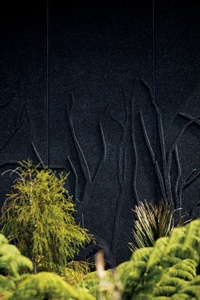
Artist, craftsman and designer Carin Wilson has created a sculptural relief on the exposed aggregate surface of the façade’s pre-cast panels which contain two stories. “One story is about what you see and the other is about what else is present in the wairua, or spirit,” explained Wilson.
At the physical level, he began by taking photographs of the site before the excavation for the building, with a view to putting the flora back into the façade. “We created digital layers from the images and built the relief patterns in the studio before forming fibreglass moulds in which to pour the concrete,” he said.
Partially concealed within this facsimile of the original foliage is a layer that evolved from an account Wilson heard from one of the team at Waitangi: of the ever-present sense of the tūpuna, or ancestors, as the ultimate kaitiaki, or protectors, of the site. This added an important layer of understanding into the otherwise time- and event-based narratives that dominate the various accounts of ‘what happened when’.
Taking their place within the panels, now the tūpuna are manifest as a more integral part of the narrative of Te Kōngahu, positioned to engage directly with the manuhiri, or visitors.
For an interview with Grant Harris of Harris Butt Architecture on the Waitangi Museum, see here. For a detailed review of the interior of the museum, click here.


